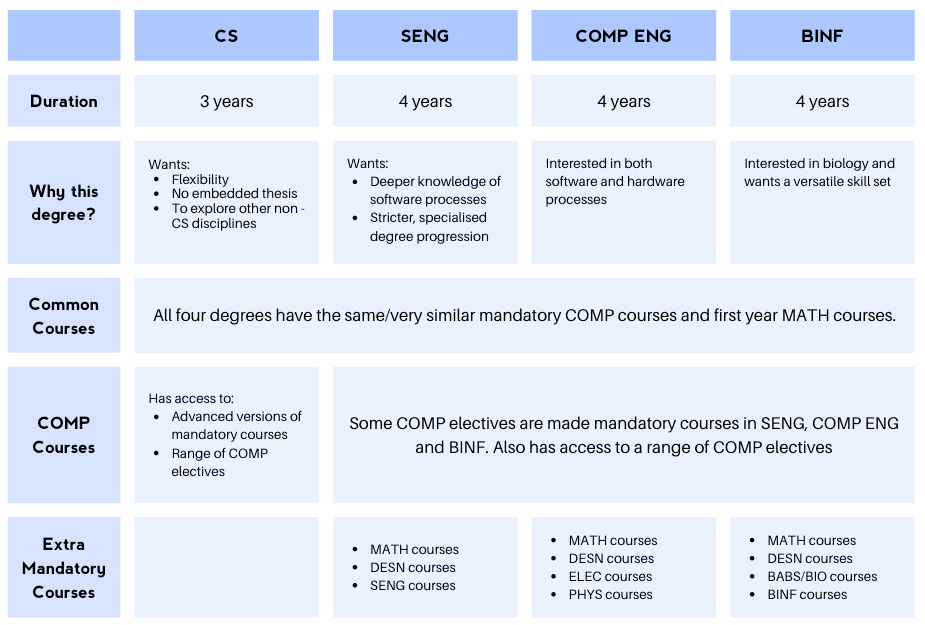CSE Degrees

What exactly counts as CSE? The School of Computer Science and Engineering is split into the following degrees: Computer Science, Software Engineering, Computer Engineering, Bioinformatics Engineering, Masters of IT (postgraduate). Many of these have a lot of overlapping courses, but exactly how different are they from each other? Let's explore and compare them in detail!
💻 Computer Science
Computer Science (CS) can be considered to be the parent to most degrees in the CSE family. The field of computer science is very broad and encompasses several subfields such as theoretical CS, computer systems, artificial intelligence and applied CS. To account for this breadth, UNSW’s offering of the CS degree is very flexible. The mandatory courses cover the fundamental principles of computer science and programming. Additionally, you have six discipline electives to take your CS degree in whichever direction you want.
Another flexibility factor is that it has six free electives and two general education courses, something that the other degrees in the CSE family lack. This allows you to explore other academic fields like Arts or Commerce. You’ll often find CS students underloading (deliberately taking less courses in a year) which extends the degree’s duration but allows them to focus on personal projects and enjoy their university experience!
P.S. NO! You don’t have to study Software Engineering to become a software engineer. CS students can learn almost all of what Software Engineering students learn. More on that in the below section!
Engineering Degrees
Unlike CS which is a degree in itself, the other degrees in the CSE family are majors within the Bachelor of Engineering (Honours). With this, the following degrees have some common attributes that can’t be found in the CS. Most notably, the Engineering degrees have an embedded thesis project. Additionally, you will be required to complete 60 days of industrial training in order to complete your degree. There are also ENGG-specific courses that are common to all engineering degrees.
🧑💻 Software Engineering
Software Engineering (SENG) is very much the fraternal twin of CS with many similarities but can also be seen as an extension of CS. SENG specialises and magnifies the processes of developing, operating and maintaining software (programs used by a computer). It builds upon your computing skill sets and refines your understanding of designing software systems, project management and software testing for quality assurance. With this, SENG has a stricter degree program with additional mandatory courses in computing, SENG, engineering fundamentals and mathematics. As an extension of CS, you may take any courses offered in CS as well!
⚙️ Computer Engineering
Computer Engineering (COMP ENG) is the child of CS and electrical engineering (ELEC) which combines the hardware and software worlds together to build computerised systems. COMP ENG builds a foundation of electrical circuit fundamentals with ELEC courses (including physics and mathematics courses) and extends this understanding with core COMP hardware-focused courses where you’ll be designing and developing integrated computer and embedded systems. You’ll also have the opportunity to explore other computing electives as well!
🧬 Bioinformatics Engineering
Bioinformatics (BINF) is a special child of biology and CS who has a mix of statistical DNA. In BINF, you’ll learn how to utilise your knowledge of computing tools and algorithms to solve biological problems! This could range from developing software for analysing DNA sequences to dynamic programming for optimising sequence alignment. This program reflects on the major theme dominating the industry: genetics, however, other thematic points include protein biology and systems biology! To address the range of topics, you’ll similarly take a range of core courses spanning much of the biotechnology and biomolecular courses and core computing courses. There are also core courses that are uniquely BINF.
TLDR

This article is from our Enrolment Guide 2023. Check out the full guide here!
Choose your next destination below:
Or click here for a list of articles!
